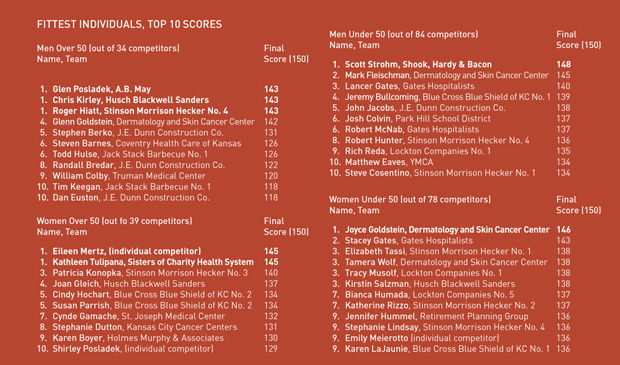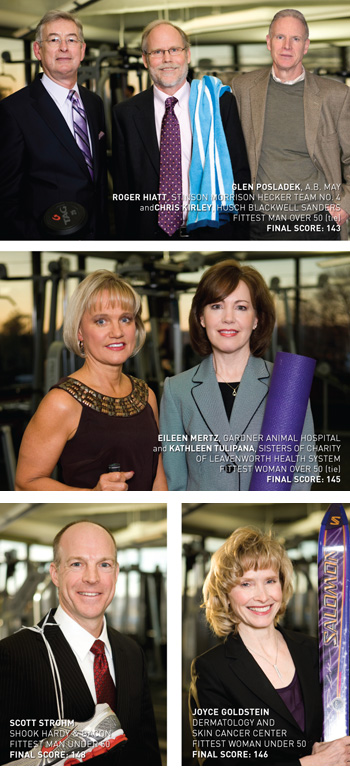Scott Strohm took part in the inaugural Fittest Execs and Fittest Companies Challenge in 2009, and did OK with it. Pushed his overall health score up eight points. This time, he wasn’t settling for just OK.
Riding a full assault of improved diet, upgraded fitness regimen and treatment for elevated cholesterol levels, Strohm soared to within two points of perfection in the 2010–2011 Challenge. He recorded the highest final score in the field of 181 contestants who finished the competition, measuring 148 on the 150-point scale.
His combined efforts made Strohm, a 44-year-old lawyer for Shook, Hardy & Bacon, this year’s Fittest Man Under 50. Joining him atop the other Fittest Individuals categories were:
• Glen Posladek of A.B. May, Chris Kirley of Husch Blackwell Sanders and Roger Hiatt of Stinson Morrison Hecker (what is it with lawyers in this competition?), who ended in a three-way tie for Fittest Man Over 50.
• Joyce Goldstein of the Dermatology and Skin Cancer Center, who followed up last year’s share of Most Improved Woman Under 50 with this year’s claim to Fittest Woman Under 50. She finished just four points short of perfection, at 146 points.
• And twin winners in the Fittest Woman Over 50 title, Kathleen Tulipana of the Sisters of Charity Health System and Eileen Mertz, who was competing as an individual.
Strohm’s ascent to the top of the field did not come without a cost: “I’ve been trying to eat a little better,” he said. “I hate vegetables, but I’m learning to at least tolerate them.”
Despite his enviable final numbers, the main take-away from the competition, he said, was the need for consistency. “I think if you keep working at it, you are bound to feel better, and that is more important than any numbers,” Strohm said. “The numbers just let you know that you are making progress—and if you aren’t, then it is good to know so you can make some changes.”
Hiatt, who showed that age is no barrier to health improvement—at 65, he was the senior member of this year’s field—said the competition also provided an extra element: “I liked the focus that it brought to my fitness routine,” he said. “I become more goal-oriented, and more focused than normal on measurable results.”
Being part of a team and in a competitive construct helped somewhat, he said, but “my goal was simply to improve my overall fitness and remain at that level of focus after the Challenge. In a sense, I decided to compete against myself … compete against where I started and do better. I did achieve that goal.”
Posladek said participation, for him, produced an additional spark. “I had already taken an interest in nutrition shortly before the competition began,” he said. “The competition gave me the added impetus to keep up my newly changed nutrition program. It also provided motivation to be more regimented in keeping up my daily exercise program.”
And, to keep the renewed focus front-and-center, Posladek said he recruited his wife into the field as an individual competitor. “It really helped that we were both working toward the same goals,” he said.
Tulipana said the metrics involved provided foundational support. “The base-line metrics and the ‘scores needed to achieve’ showed me exactly where I needed to focus to compete, and more importantly to achieve my long-term health goals.
She also said structure of the Challenge, running at more than three months duration, “allowed for an occasional set-back followed by a re-commitment, which I think contributes to sustainable improvement.”
Mertz, a veterinarian with a private practice in Gardner, said she found renewed commitment to fitness after turning 50. She lost 20 pounds even before the competition began in August, and five more before December, thanks to a regular regimen of running, strength-training, ballroom/salsa dancing, yoga and improved diet. ![]()


